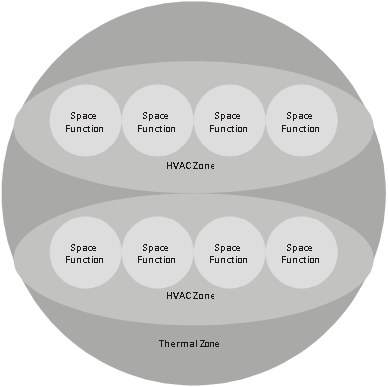
A thermal zone is a space or collection of spaces within a building having sufficiently similar space conditioning requirements so that those conditions could be maintained with a single thermal controlling device. A thermal zone is a thermal and not a geometric concept: spaces need not be contiguous to be combined within a thermal zone. Daylighting requirements, however, may prevent combining noncontiguous spaces into a thermal zone.
An HVAC zone is a physical space within the building that has a thermostat and zonal system for maintaining thermal comfort. HVAC zones are identified on the HVAC plans. HVAC zones should not be split between thermal zones, but a thermal zone may include more than one HVAC zone.
A space function is a subcomponent of a thermal zone that has specific standard design lighting requirements and for which there are associated defaults for outside air ventilation, occupancy, receptacle loads, and hot water consumption. An HVAC zone may contain more than one space function. Appendix 5.4A has a list of the space functions that may be used with the software. Daylighted areas should generally be defined as separate space functions, even if they have the same classification from Appendix 5.4A, so that lighting reductions due to daylighting can be determined at the appropriate resolution.
Figure 1 shows the hierarchy of space functions, HVAC zones and thermal zones
